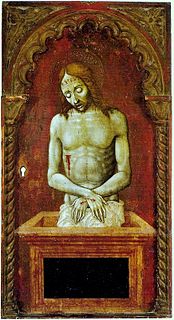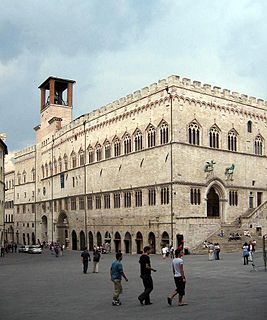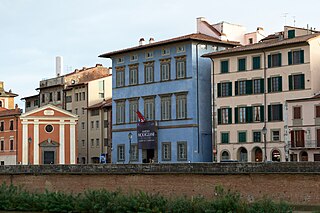Collections
The Museum preserves paintings by artists such as Fra Angelico, Giorgione (Double portrait, about 1502), Giotto, Benozzo Gozzoli, Guercino, Carlo Maratta, Pisanello (Head of a woman), Guido Reni, Giorgio Vasari, Alessandro Algardi, Gian Lorenzo Bernini, as well as pastels, sculptures, bronzes, majolica, terracotta, western and oriental porcelain, medals, seals, furniture, weapons, ivories, silver, glass, enamels, fabrics and tapestries [2] . It also preserves approximately 3,000 works from the Wurts Collection, which was formed by George Washington Wurts and Henrietta Tower and bequeathed to the Italian state on her death in 1933.
The external loggia (Garden of Paul II) houses a lapidarium.
The museum also hosts temporary exhibitions.

John VIII Palaiologos or Palaeologus was the penultimate Byzantine emperor, ruling from 1425 to 1448.

The Doge's Palace is a palace built in Venetian Gothic style, and one of the main landmarks of the city of Venice in northern Italy. The palace was the residence of the Doge of Venice, the supreme authority of the former Republic. It was built in 1340 and extended and modified in the following centuries. It became a museum in 1923 and is one of the 11 museums run by the Fondazione Musei Civici di Venezia.

Domenico Veneziano was an Italian painter of the early Renaissance, active mostly in Perugia and Tuscany.

Fiorenzo di Lorenzo was an Italian painter, of the Umbrian school. He lived and worked at Perugia, where most of his authentic works are still preserved in the Galleria Nazionale dell'Umbria.

Pisanello, born Antonio di Puccio Pisano or Antonio di Puccio da Cereto, also erroneously called Vittore Pisano by Giorgio Vasari, was one of the most distinguished painters of the early Italian Renaissance and Quattrocento. He was acclaimed by poets such as Guarino da Verona and praised by humanists of his time, who compared him to such illustrious names as Cimabue, Phidias and Praxiteles.

Benozzo Gozzoli was an Italian Renaissance painter from Florence. A pupil of Fra Angelico, Gozzoli is best known for a series of murals in the Magi Chapel of the Palazzo Medici-Riccardi, depicting festive, vibrant processions with fine attention to detail and a pronounced International Gothic influence. The chapel's fresco cycle reveals a new Renaissance interest in nature with its realistic depiction of landscapes and vivid human portraits. Gozzoli is considered one of the most prolific fresco painters of his generation. While he was mainly active in Tuscany, he also worked in Umbria and Rome.

Montefalco is a historic small hill town in Umbria, Italy, with a population of 5,581 in August 2017. It has been settled since pre-Roman times, and retains many of its historic buildings. From 1446 to 1861 it was part of the Papal States. Montefalco DOC is a regulated geographical area for its wine, the reds usually including the highly localized Sagrantino grape variety. The town's museum is in a former church, which has a fresco cycle on the life of St. Francis by the Florentine artist Benozzo Gozzoli (1450–1452).

The Palazzo Medici, also called the Palazzo Medici Riccardi after the later family that acquired and expanded it, is a Renaissance palace located in Florence, Italy. It is the seat of the Metropolitan City of Florence and a museum.

Antoniazzo Romano, born Antonio di Benedetto Aquilo degli Aquili was an Italian Early Renaissance painter, the leading figure of the Roman school during the latter part of the 15th century. He "made a speciality of repainting or interpreting older images, or generating new cult images with an archaic flavor", in particular by very often using the gold ground style, which was unusual by this period.

Giovanni Cariani, also known as Giovanni Busi or Il Cariani, was an Italian painter of the high-Renaissance, active in Venice and the Venetian mainland, including Bergamo, thought to be his native city.

Niccolò di Liberatore, known as L'Alunno (1430–1502) was an Italian painter of the Umbrian school.

Portrait of Princess is a tempera painting on panel attributed to the Italian Late-Gothic master Pisanello. It was probably executed between 1435 and 1445 and is also known as Portrait of a Princess of the House of Este. It is firmly attributed to Pisanello on stylistic grounds and because he stayed in Ferrara in the period, where he also finished a portrait and a celebrative medal of Marquis Leonello d'Este.
The decade of the 1460s in art involved some significant events.
The decade of the 1450s in art involved many significant events, especially in sculpture.

The Magi Chapel is a chapel in the Palazzo Medici Riccardi of Florence, Italy. Its walls are almost entirely covered by a famous cycle of frescoes by the Renaissance master Benozzo Gozzoli, painted around 1459 for the Medici family, the effective rulers of Florence.

The Galleria Nazionale dell'Umbria the Italian national paintings collection of Umbria, housed in the Palazzo dei Priori, Perugia, in central Italy. Located on the upper floors of the Palazzo dei Priori, the exhibition spaces occupy two floors and the collection comprises the greatest representation of the Umbrian School of painting, ranging from the 13th to the 19th century, strongest in the fourteenth through sixteenth centuries. The collection is presented in 40 exhibition rooms in the Palazzo. On the second floor of the Gallery, there is an exhibition space for temporary collections, changed several times a year.

The Palazzo Comunale, also known as the Palazzo del Popolo of San Gimignano has been the seat of the civic authority in the comune since the 13th century. It is located on the Piazza del Duomo close to the Collegiate Church of the Assumption of the Blessed Virgin Mary. The building and Collegiate Church are at the heart of the medieval town, and are part of the UNESCO World Heritage Site of the "Historic Centre of San Gimignano".

Alesso di Benozzo, also known as Alesso Gozzoli, was an Italian Renaissance painter. He was born in Pisa in 1473 and began his career as an assistant to his father, the famous Florentine Benozzo Gozzoli. In 1492 he signed the Tabernacle of the Visitation together with his father, who headed the project, and brother, Francesco. Because of their similar styles, the individual contributions of each painter are not easy to distinguish, but the art historian Anna Padoa Rizzo has proposed that the more refined and elegant figures are by Alesso, whom documents suggest was Gozzoli's most esteemed son, and that the coarser passages are by Francesco, apparently of lesser renown. Padoa Rizzo in turn identified Alesso as the anonymous artist previously known by two names: the "Maestro Esiguo," invented by Roberto Longhi in reference to the painter's skinny and exiguous figures, and the "Alunno di Benozzo," literally the "student of Benozzo," a nickname invented by Bernard Berenson. His works were also once wrongly assigned to Amedeo Laini, called Amedeo da Pistoia.

Palazzo Blu is a center for temporary exhibitions and cultural activities located in 9 Lungarno Gambacorti, in the heart of the historic center of Pisa, Italy. This museum is managed by the Fondazione Palazzo Blu, and is located in the Palazzo Giuli Rosselmini Gualandi, ancient palace restored by the Fondazione Pisa. Its name comes from the blue color uncovered during an architectural recent restoration, and attributable to the taste of Russian owners who acquired the Palazzo in the eighteenth century.
George Washington Wurts was an American diplomat and art collector.






















